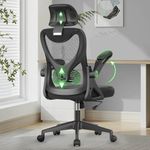Buying Guide for the Best Ergonomic Office Chairs
Choosing the right ergonomic office chair is crucial for maintaining good posture and preventing discomfort during long hours of work. An ergonomic chair is designed to support the natural curve of your spine and provide comfort, which can enhance productivity and reduce the risk of musculoskeletal issues. When selecting an ergonomic office chair, consider the key specifications that will ensure the chair meets your individual needs and preferences.Adjustable Seat HeightAdjustable seat height is a feature that allows you to change the height of the chair to suit your body size and desk height. This is important because it ensures that your feet are flat on the floor, your knees are at a 90-degree angle, and your arms are at the right height relative to your desk. Typically, a good ergonomic chair will have a seat height range of about 16 to 21 inches off the floor. If you're taller or shorter than average, look for chairs with a wider range of adjustment to ensure comfort.
Lumbar SupportLumbar support refers to the chair's ability to support the lower back, which is crucial for maintaining the natural inward curve of the spine. This support helps prevent back pain and promotes good posture. Chairs with adjustable lumbar support allow you to customize the fit to your lower back, which is especially important if you spend long hours sitting. If you have specific back issues, look for chairs with more advanced lumbar support features.
Seat Depth and WidthSeat depth and width are important for ensuring that the chair fits your body comfortably. The seat should be deep enough to allow you to sit with your back against the backrest while leaving a gap of about 2 to 4 inches between the back of your knees and the seat. The width should be wide enough to accommodate your hips without feeling cramped. If you're taller, look for chairs with deeper seats, and if you're wider, ensure the seat width is sufficient for comfort.
BackrestThe backrest of an ergonomic chair should support the natural curve of your spine and be adjustable in height and angle. This is important for providing support to your upper and lower back, reducing strain and promoting good posture. Some chairs offer a reclining feature, which can be beneficial for taking breaks and reducing pressure on your spine. Consider your work habits and whether you prefer a more upright or reclined position when choosing a backrest.
ArmrestsArmrests provide support for your arms and help reduce strain on your shoulders and neck. Adjustable armrests are important because they allow you to position your arms comfortably, which can prevent fatigue and improve posture. Look for armrests that can be adjusted in height, width, and angle to suit your body and work style. If you frequently use a keyboard or mouse, ensure the armrests can be positioned to support your arms while typing.
Material and PaddingThe material and padding of an ergonomic chair affect its comfort and durability. Breathable materials like mesh can keep you cool during long hours of sitting, while leather or fabric may offer a more luxurious feel. Padding should be firm enough to provide support but soft enough for comfort. Consider your personal preference for material and the climate of your workspace when choosing a chair. If you tend to get warm, opt for breathable materials.
Swivel and CastersSwivel and casters allow you to move easily in your workspace without straining. A swivel feature lets you rotate the chair, which is useful for multitasking and accessing different areas of your desk. Casters enable smooth movement across the floor, which is important for mobility and convenience. Consider the type of flooring in your workspace when choosing casters; hard casters are suitable for carpet, while soft casters are better for hard floors.

















